How a Below-Slab Vapor Barrier Contributes to a High-Performance Home
Help Meet Four High-Performance Goals with Effective Below-Slab Vapor Protection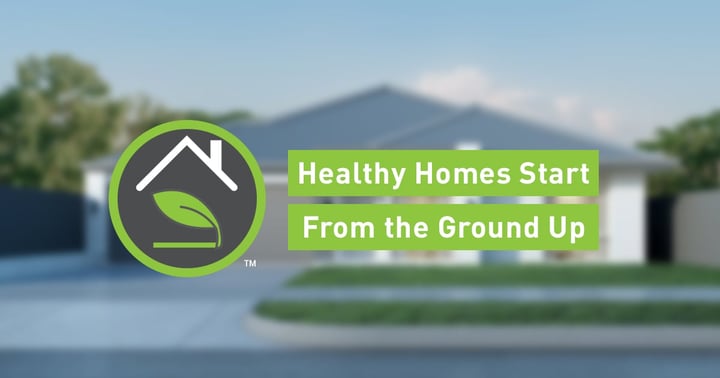
We hear a lot from both homeowners and homebuilders who are looking for any design techniques, products, and systems to contribute to a higher-performance home. Whether it’s your dream home or you’re a homebuilder, the goal should be the same for your healthy, safe, comfortable, and sustainable home: go beyond the minimum residential code to design and construct a better place to live.
High-performance homes are in demand among homeowners and prospective buyers, who have more information at their fingertips than ever before; recognizing this, many homebuilders are building for performance to:
- Add value to their customers’ investments
- Demonstrate a core commitment to being a “responsible” builder
- Differentiate themselves in a competitive marketplace
Our goal (and the purpose of this article) is always to provide a clear understanding of vapor transmission on the first side of the home - the foundation - and the role below-slab vapor barriers play in achieving high-performance goals in new homes.
Let's Start with Some Building Science
Regardless of where a home is constructed, there is moisture in the ground at some depth below (generally the water table) or around the foundation -- think of rain falling to the ground and seeping into the soil, for example. Homebuilders have always gone to great lengths to prevent the infiltration of liquid water into the home’s foundation through proper drainage, capillary breaks, waterproofing, etc.
However, water vapor – the invisible/gaseous form of water – is also continually “working” to move into the interior of your home.
A basic building science principle, in simplified form, is that water vapor moves from “more to less.” In the below-slab environment (the earth beneath your home) water vapor is 1) always present and 2) abundant, compared to the interior of your home; your roof, weather barriers, insulation, HVAC, and other components are all trying to keep the home dry and comfortable, after all.
This higher concentration of water vapor in the earth means that under-slab moisture will constantly be moving into the building from below. This movement of water vapor from higher to lower concentrations is known as diffusion and is one of two primary means by which water vapor will migrate through the foundation of a home.

This clip illustrates how water vapor encounters more resistance moving horizontally through a slab cast in place.
The second way water vapor can move into the home from below is advection. Advection is the process where vapor is carried in a medium (in this case, air) due to pressure differentials. This bulk air, as well as the water vapor or soil gases (more on this later) within it, will find pathways to enter the often lower pressure interior environment of the home -- any holes, leaks, or other discontinuities in the building envelope.
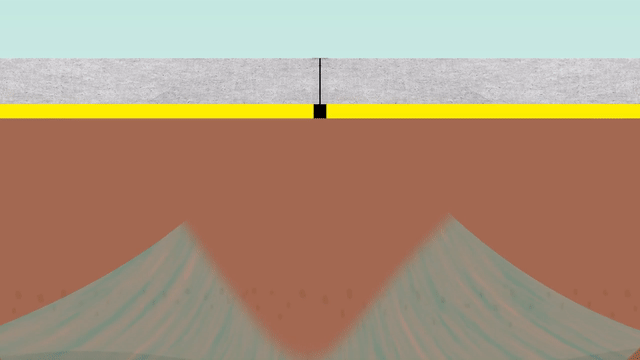
This clip demonstrates how vapor barrier holes can be an avenue for advection.
We can shut down advection by creating an air-tight envelope, but as long as there’s water beneath your home (and there always is), diffusion never stops.
What makes matters worse for your home’s foundation is that concrete – despite its tough texture and reputation – is not vapor-proof. Left unchecked, water vapor will continually diffuse toward the interior of the home through the concrete slab-on-grade or basement floor over time.
Concrete will slow it down, and components in your home, like flooring, will impede it. This is not good news: vapor can accumulate and develop a higher localized relative humidity, which is the amount of water vapor in the air compared to how much the air can hold at a given temperature. When it can’t hold any more vapor, you get condensation, a common culprit for moisture-related issues in homes. Stopping this natural movement of water vapor from below the concrete slab before it gets into the home is critical.
The Solution is Below-Slab Vapor Protection
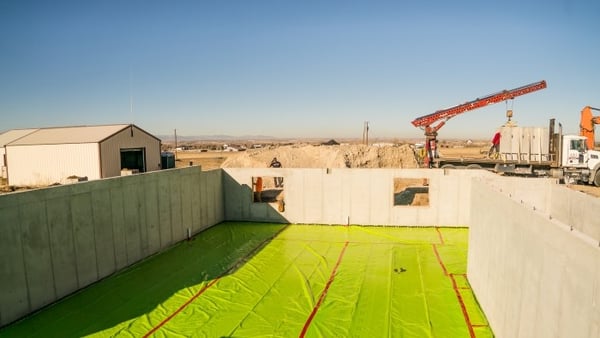 A below-slab vapor barrier or vapor retarder, a thin-gauge plastic sheet, is typically installed directly beneath concrete floor slabs. This role is critical, and it’s a job that cannot be done by just any generic plastic film. So, while it may just look like “a sheet of plastic,” the below-slab vapor barrier is not simply a commodity, but an important component to the home’s envelope and its overall long-term performance.
A below-slab vapor barrier or vapor retarder, a thin-gauge plastic sheet, is typically installed directly beneath concrete floor slabs. This role is critical, and it’s a job that cannot be done by just any generic plastic film. So, while it may just look like “a sheet of plastic,” the below-slab vapor barrier is not simply a commodity, but an important component to the home’s envelope and its overall long-term performance.
Below-slab vapor protection is necessary (and often required) in new home construction but choosing the right vapor barrier (and not just another “sheet of plastic”) can play a role in helping achieve high-performance goals for your home.
What is a High-Performance Home?
Depending on who you survey, conventional thinking describes a high-performance home as maximizing human health, durability, and energy performance, as well as reducing environmental impact. In fact, the industry has a multitude of residential building rating systems and certifications that offer pathways and benchmarks for better homes and include these key outcomes – Passive House, LEED for Homes, NGBS, Net Zero, EPA IndoorAir Plus, and WELL, just to name a few.
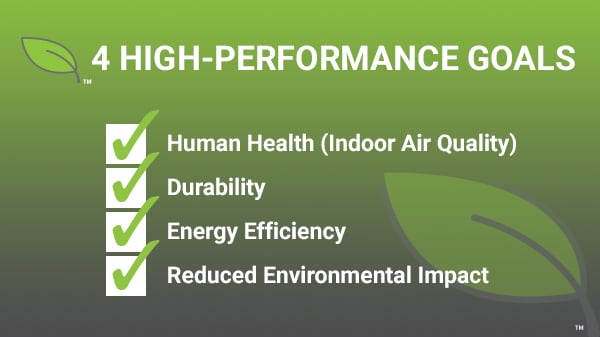 Let’s look a little closer at these four high-performance goals and how effective below-slab vapor protection fits in.
Let’s look a little closer at these four high-performance goals and how effective below-slab vapor protection fits in.
- Human Health (Indoor Air Quality): although there are many components to a healthier home, a critical piece is reducing the presence of harmful indoor air pollutants and contaminants to improve indoor air quality (IAQ). Proper ventilation providing fresh, clean air is a big part of the indoor air quality equation, but it also starts with keeping bad things out of the home in the first place.
Mold has been a hot-button topic for decades because its growth in homes has the potential to cause health problems for occupants. But mold can only survive in an environment with sufficient moisture. Making sure the home stays dry and at a lower interior humidity will help prevent the potential for harmful mold growth.
Another common health concern for new homes is radon gas. Radon is a naturally occurring gas in soils that, like water vapor, can move into the home from beneath the foundation as we described earlier. Radon is the second leading cause of lung cancer in the United States and most new homes (and many older ones), now incorporate radon mitigation systems. An under-slab vapor barrier (also referred to as a “soil-gas retarder”) is an important component for radon-resistant new construction. - Durability: there is a tremendous impact on a home’s performance when parts aren’t built to last or simply need avoidable maintenance over time. Replacing or fixing building components generates waste and can have an impact on both the time and wallet (and probably sanity) of homeowners. More and more, homeowners are doing their own research to identify components that will make their homes durable, resilient, and represent a lower long-term cost of ownership. That’s why many homebuilders, understand they need to bring their potential customers genuine quality and value.
The transmission of moisture vapor into a home from below the foundation can have a significant impact on building components. Most common and costly among these impacts is the potential for floor covering and adhesive failures. Some flooring materials themselves, like hardwoods, can absorb moisture leading to cracking and cupping. Others, like rubber-backed carpet or resilient flooring, allow water vapor to accumulate and condense, leading to mold growth or breakdown of adhesives.
Whether it is a basement or slab-on-grade, you only have one good chance to put effective vapor protection beneath your concrete floor. Once your concrete slab is placed, there is no easy do-over. Doing it right the first time is critical not only for homeowner peace of mind but potential liability for builders. When you select a proper system and install it effectively, the under-slab vapor barrier can be a maintenance-free, permanent solution. - Energy Efficiency: energy performance is typically where people start when they start their high-performance research. It’s critical to the comfort, operational costs, and overall environmental impact of a home. There are many ways to design and construct a more energy-efficient home. For example, taking advantage of renewable energy sources and technology (like solar panels) to offset or reduce energy needed from the electrical grid or combustible energy sources. You can also use lighting and appliances that are designed to consume less energy.
But a big, unseen factor in energy efficiency is also creating tight, well-insulated homes that reduce the load on the HVAC system. Your first summer electricity bill (or winter gas bill) teaches every homeowner that HVAC equipment is a huge energy drag while keeping the home comfortable in heating, cooling, and potentially filtering the air in the home.
Passive solutions to maintaining a comfortable temperature (reducing air leakage, utilizing insulation) and preventing the ingress of unchecked water vapor—which adds to the latent load and can adversely affect building materials—can be a hidden key for energy efficiency. - Reduced Environmental Impact: a high-performance home will also be more sustainable in its impact on our natural environment. Better-designed homes make this connection obvious: more durable homes mean fewer repairs and replacement of components, meaning less waste to the landfill and reduced carbon emissions associated with that work. Similarly, improved energy efficiency means less power needed from non-renewable energy sources. But we can also look holistically at the building products themselves and their impact on our future world.
There has been a lot of progress in the building product landscape with how products are engineered, understanding greenhouse gas emissions along the product lifecycle, and manufacturer commitments around environmental and social health. Homeowners and builders can make better-informed choices about products with transparent information available that helps explain things like ingredients, volatile organic compound (VOC) emissions, and potential human health hazards of building products, as well as the embodied carbon and corporate responsibility of the companies who make them.
So, what should homeowners and homebuilders look for when incorporating a below-slab vapor barrier into new high-performance homes?
- Low Water Vapor Permeance: look for a high-performance vapor barrier that provides a very low water vapor permeance rating, which is the measure of how easily water vapor moves through the membrane. The lower the permeance, the better. A “vapor barrier” permeance of 0.01 perms or less is an industry-established threshold and will significantly reduce the amount of potential water vapor that can contribute to moisture-related concerns in the home. Compare that to generic, 6-mil polyethylene sheeting, and a vapor barrier with less than 0.01 perms will provide roughly a 90% reduction in yearly water vapor transmission through a 1,300ft² new home footprint.
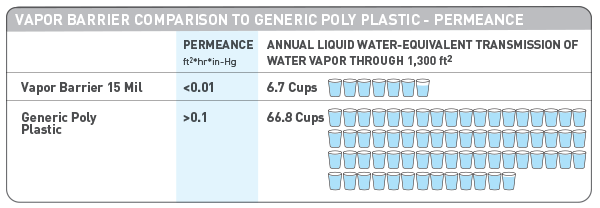
- Meets ASTM E1745: this is a published industry performance standard written specifically for below-slab vapor barriers and retarders. It outlines minimum requirements around strength and permeance, but also includes conditioning testing which simulates the below-slab environment. Products that meet this standard are engineered for this purpose and will resist degradation over time. A permanent solution that maintains its performance over the life of the home is crucial to the durability and a lower cost-of-ownership of any new home. Generic, off-the-shelf polyethylene sheeting (often 6-mil thick) does not usually meet this performance standard and can present critical problems beneath a concrete slab.
- Effective Installation: like any building envelope component of a new home, proper installation and detailing is critical to the performance of the system. For the below-slab vapor barrier, an effective installation is not only important for preventing water vapor diffusion, but also to create an air-tight system to impede the bulk movement of soil gases like radon or moist air due to pressure differentials. Look for a below-slab vapor barrier that has a full, integrated system approach to the installation, as well as the details and support to ensure it is done effectively and efficiently. Get a 5-Step Guide to Installing a Residential Below-Slab Vapor Barrier.
- Go Beyond the Data Sheets: consider the manufacturer behind the vapor barrier product. This is where you begin to see significant differences in product quality and consistency, warranties, support and education, and commitments around environmental and social responsibility. For many homeowners and homebuilders, these things go hand-in-hand with the performance, availability, and costs of products and align with the overall goal of a better home.
High-Performance, Healthy Homes Start at the Foundation
Still think it’s “just a sheet of plastic?” A lot of engineering, chemistry, and building science goes into this integral product for your home’s foundation! It may not be as compelling as solar panels to your home’s performance – or as fun to pick out as sustainable appliances – but this level of research into the first side of your high-performance home will deliver you unmatched protection and durability for the life of your home.

Written by Tom Marks
Tom Marks is the Business Development Project Manager with Stego Industries, LLC. He has been with Stego since 2007, serving many years as the Rocky Mountains Regional Manager. Now, his focus is geared toward vapor barrier solutions for new and existing homes as the Product Manager of the StegoHome and StegoCrawl brands. In addition, Tom serves as Sustainability Manager, overseeing Stego’s leadership in holistic product and corporate sustainability. Tom enjoys working with a wide range of project team members and customers to incorporate effective sub-slab vapor protection and create healthy, sustainable homes and buildings.
- Stego (26)
- StegoCrawl (24)
- Stego-Awareness (17)
- StegoHome (15)
- Case Studies (14)
- StegoCrawl-Consideration (12)
- StegoCrawl-Awareness (11)
- Customer Stories (9)
- Stego-Consideration (9)
- Pango (8)
- StegoHome-Consideration (8)
- Beast (7)
- How to Install (7)
- StegoHome-Awareness (7)
- Drago (5)
- Pango-Awareness (5)
- Beast-Awareness (4)
- Beast-Consideration (3)
- Drago-Awareness (3)
- Pango-Consideration (3)
- Stego IQ (3)
- Drago-Consideration (2)
- StegoCrawl-Decision (2)
Popular Posts
Stay Connected.
Enter your email below.




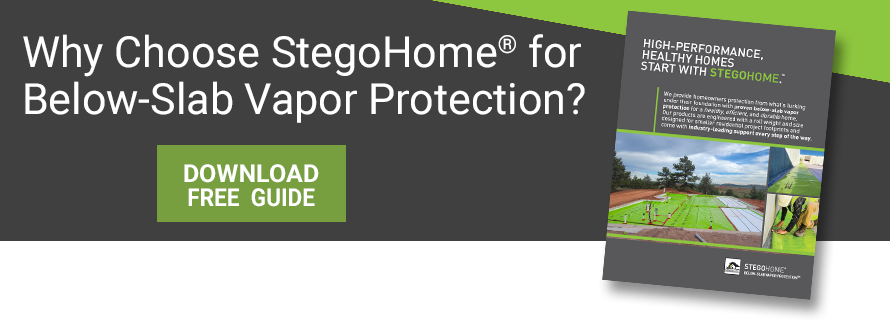


Post Comments